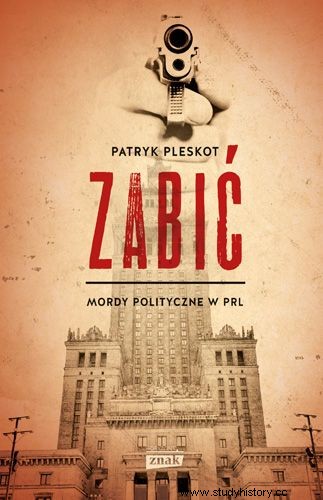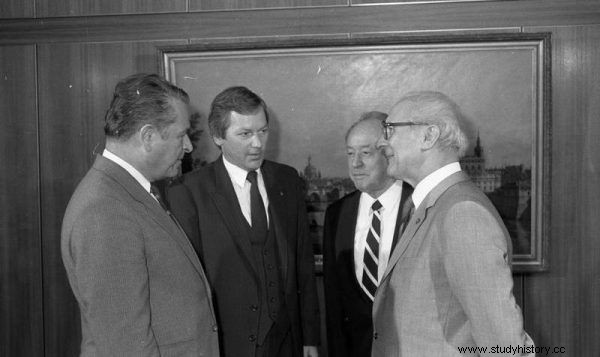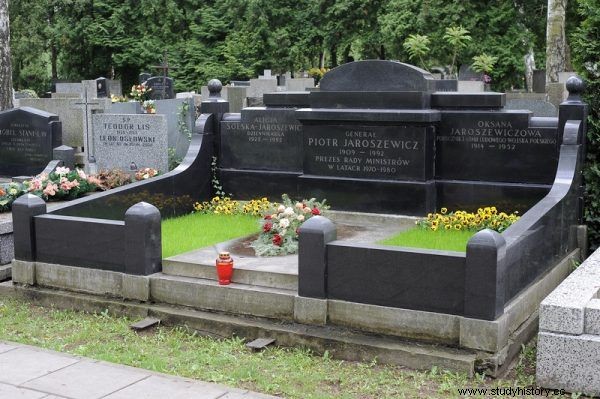In 1945 he discovered a secret Nazi archive in Lower Silesia. Half a century later he was murdered, and his fate was shared by two other people involved in the case. Sounds like a movie script, but it really happened. We are the first to present a comprehensive overview of the hypotheses, suspicions and clues in the case.
Piotr Jaroszewicz did not part with his Walther pistol. He always carried the weapon with him, even in the privacy of his home. He had reason to believe that he would have to pay with his life for his knowledge. Especially since he knew more secrets than the one from 1945.
The period 1970-1980 was the peak of his political career. Then he was the prime minister of the People's Republic of Poland. It was the culmination of many years of climbing the ranks of the state apparatus. Earlier, Jaroszewicz was, inter alia, deputy prime minister, deputy, minister, general of the People's Army of Poland and a member of the Central Committee. If he lived today, could certainly tell more about the apparatus of power than Stanisław Kania - the last living First Secretary of the Central Committee of the Polish United Workers' Party.
Private Archive
One of the most popular hypotheses regarding the death of the prime minister and his wife, murdered that same night in a villa in Anin, links the case with a secret Nazi archive found in Radomierzyce in Lower Silesia. Its resources were to include information on, inter alia, Nazi agents. And this is an agency functioning even in the circles of Western politicians.

Prime Minister Piotr Jaroszewicz at the apex of his career. Sitting in his office, did he expect the cruel death to come? (source:public domain)
There is a suspicion that Piotr Jaroszewicz may have hidden some of the documents. But why would it only die half a century after its sensational discovery? Perhaps because immediately before his death he was working on the second, extended version of his book "Breaking the Silence".
The first edition, published in 1991, was of an interview-river nature. The details of the latter remain unknown as the notes are lost. It is only known that Jaroszewicz planned to reveal some secrets in the publication. Could the persons affected by the documents from Radomierzyce feel threatened and therefore order the murder of the old man?
The hypothesis of this probability is added by the fact that two companions of Piotr Jaroszewicz were also killed, allegedly involved in the archive discovery. They were both murdered in the 90's.
The chatty NKVD general
Some historians believe that Jaroszewicz's murder was related to the death of Karol Świerczewski in 1947. According to the official version, the infamous communist general was killed then by the so-called Ukrainian Insurgent Army.

General Karol Świerczewski found coins and banknotes. And people who knew the truth about his death ended up in the sand ... (photo:Pesell, license CC BY-SA 4.0).
However, there are many indications that it was not an accidental attack by partisans, but a planned attack. It was performed on a man to whom the NKVD general Georgij Sergeyevich Zhukov, under the influence of alcohol, revealed the secret of the so-called "Matryoshka". They were Soviet doubles, allegedly being substituted for state officials in Europe. To this day, there are speculations as to whether the Russians did not send such a person to Poland to replace Bolesław Bierut, or even Wojciech Jaruzelski ...
This article has more than one page. Please select another one below to continue reading.Attention! You are not on the first page of the article. If you want to read from the beginning click here.

The article was written, among others based on the book by Patryk Pleskot "Kill. Political murders in the People's Republic of Poland ”(Znak Horyzont 2016).
The extensive investigation into the death of Karol Świerczewski brought mixed results. Colonel Jan Gerhard, an eyewitness and one of the main investigators, spent two years in prison in the 1950s on charges of complicity. Then, when in the early '70s he decided to recreate the events again, militiamen found him dead in his own apartment.
For his killing, two people were sentenced to death, who allegedly had motives completely unrelated to the case of Karol Świerczewski. Nevertheless, to this day historians wonder whether the moment of Gerhard's murder was accidental.
As Patryk Pleskot writes in his latest book "To kill. Political murders in the People's Republic of Poland "Gerhard, like Jaroszewicz, worked before his death on publishing memoirs that could shed new light on the alleged skirmish with partisans. Consequently, the death of the general would have a deeper meaning:to avoid the dissemination of information about "matryoshkas". It is possible that Gerhard knew the details of the case.
Was Jaroszewicz killed because after the war, as Deputy Prime Minister, he received information from Karol Świerczewski about the doubles?

The matryoshkas - even the ones depicting Russian leaders - look quite innocent. Was there more to that name? (photo:Brandt Luke Zorn, license CC BY-SA 2.0)
Comrades from the PZPR
It is also hard to resist the impression that the prime minister may have been inconvenient for some because of much more recent events than those from the 1940s. His many years of career ended with a bang with the fall of Edward Gierek's government. Jaroszewicz probably could not forgive the new ruling team, headed by Wojciech Jaruzelski and Czesław Kiszczak, for the loss of positions and internment under martial law. For the former prime minister and general, the mere circumstances of his arrest by low-ranking soldiers were a huge disgrace.
Jaroszewicz survived the last 10 years of the existence of the People's Republic of Poland on the sidelines. When communism fell, his hands were no longer tied. There are suspicions that he had hooks (and most of all:he intended to expose them) to people such as Jaruzelski and Kiszczak. This, in effect, leads to the next version of events. Jaroszewicz could have died on the order of someone from the circles of the late PZPR, who wanted to secure their position in the new reality.

Czesław Kiszczak (first from left) at a meeting with East German leader Eric Honecker. Did Jaroszewicz have any information that could disrupt his peaceful retirement in the Third Polish Republic? (Bundesarchiv, Bild 183-1988-0629-035 / CC-BY-SA 3.0)
Today it is difficult to say unequivocally what could have been in the writings of the former prime minister. It is not even known whether they were taken during the robbery at all, or whether they were simply kept outside the house on a daily basis.
Almost nothing was lost from the stately villa of the Jaroszewicz family. At the scene, the police found a huge amount of weapons from Piotr's collection, money, valuables, and even an unopened safe, the door of which the criminals could surely breach given that they had been in the house for quite a long time.
The Prime Minister's wife, Alicja, was found on the floor in the bathroom. A bullet fired from the rifle pierced her head. On the other hand, the policemen found Piotr's body in an armchair in the room. He was beaten, bloodied and importantly only one of his hands was tied to the backrest. Was he forced to sign something during long torture?
Common robbers
What happened in the Jaroszewicz house was not the only attack in the area at that time. Consequently, the police assumed that the marriage was simply a victim of ordinary robbers. They may not even know whose home they are entering. The fact that the former prime minister lived in the villa was not widely known.
This article has more than one page. Please select another one below to continue reading.Attention! You are not on the first page of the article. If you want to read from the beginning click here.
It is possible that Jaroszewicz was tortured to force him to identify the places where the cash was hidden. The choking with a hunting weapon belt was therefore only intended to intimidate the victim, not kill him. The former prime minister has passed away because he was already over 80, for which the robbers did not take the amendment. The criminals could then panic and therefore kill his wife as well.

In this magnificent tomb in Powązki, the victims of the Anin murder are buried (photo:Cezary p, license from GFDL).
The police, assuming the hypothesis of an ordinary robbery, arrested a group of four burglars from Mińsk Mazowiecki two years after the incident. They were burdened, inter alia, by testimony of the partner of one of them. After a long trial that proved nothing, the prosecutor asked for the complete acquittal of the gang members.

The article was written, among others based on the book by Patryk Pleskot "Kill. Political murders in the People's Republic of Poland ”(Znak Horyzont 2016).
Patryk Pleskot also mentions about the relatively little-known story of a man arrested by the police who confessed during the interrogation that he had taken part in the preparations for the attack on the Jaroszewicz house. He showed quite extensive knowledge about the villa in Anin, which only made his words credible. However, this was not followed.
It was similar with the story about the prowling, among others in Warsaw's Old Town szajki. Her methods were very similar to those used by the Jaroszewicz killers. It was quickly decided to abandon the hypothesis linking these two matters.
A perfect crime?
The law enforcement agencies returned several times to investigate the murder of the prime minister. At one point, the police decided to re-examine the fingerprints in the case file. Then it turned out that disappeared without a trace. The circumstances of their disappearance have not been clarified to this day.
Some time ago, there was also information pointing to the existence of unexplored traces of blood on the carpet still in the villa in Anin. This was extremely valuable information, especially since the policemen dealing with the case in 1992 mentioned that perfume was spilled during the attack on some stains.
This was probably done to make it impossible to perform thorough research. Interestingly, the blood belonged to one of the attackers, not the victims. However, the police were not interested in it at all. No samples were taken!

These fingerprints, collected 150 years ago, are still viewable. But the traces of the Jaroszewicz case evaporated… (source:public domain).
Almost 25 years after the murder of the Jaroszewicz couple, everything indicates that the perpetrators will never be detected. As a result, we can only speculate, whether in a house full of valuables, from which almost nothing was lost, there was an ordinary robbery, or not ... Was the answer hidden in the missing scratch-paper of the book?
